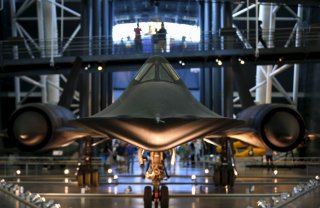The Legendary SR-71 Blackbird Almost Never Got Airborne
Here is the full story about how the Blackbird almost didn’t have an opportunity to achieve its prominent place in aviation history.
Here's What You Need to Remember: Gen. Curtis LeMay, then the vice chief of staff of the Air Force, approached Lockheed Martin’s Kelly Johnson and asked for something specific: an update of the A-12 Oxcart, to create “an extended range deep penetration bomber that the Russians could not stop.”
The SR-71 Blackbird is one of the most famous planes ever used by the U.S. military. It is believed to be the fastest plane ever flown. Also, it was never shot down in combat.
A new report looks at how the Blackbird almost didn’t get to that prominent place in aviation history.
According to Aviation Geek Club, it all happened in 1961. Gen. Curtis LeMay, then the vice chief of staff of the Air Force, approached Lockheed Martin’s Kelly Johnson and asked for something specific: an update of the A-12 Oxcart, to create “an extended range deep penetration bomber that the Russians could not stop.”
Also, he wanted a “two-seat version of the A-12,” which was meant to “survey the damage after World War III.”
This request led to the YF-12 prototype interceptor, several of which were ordered during the 1960s. The creation of the interceptor eventually led to an order for the XB-70 Valkyrie Mach 3 strategic bomber.
However, both bomber aircraft were canceled and the Blackbird’s rise came soon afterward.
“The worries about World War III were subsided when the US found out, that the Russian’s nuclear arsenal buildup had been exaggerated and that they were not on the brink of developing a supersonic bomber. But this was the beginning and this led to the Skunk Works building 31 SR-71s,” according to the Aviation Geek Club.
LeMay is known for the role he played during the Vietnam War. It was then when he suggested that the United States “bomb them back into the Stone Age.”
“While the A-12 had been designed specifically to serve as a viable replacement for the high-flying, but much slower, U-2 spy plane, the U.S. Air Force was also on the hunt for a new fighter that could replace the F-106 Delta Dart interceptor,” Alex Hollings said of the YF-12 in a blog he wrote for Sandboxx News. “While the Delta Dart was designed to be ‘the ultimate interceptor,’ the rapidly advancing aviation technology erupting from think tanks on both sides of the Iron Curtain soon made it clear that the F-106’s Mach 2.3 top speed wasn’t quite as “ultimate” as it had seemed at its inception. Like so many forward-reaching aircraft to come about during the Cold War, the F-106’s biggest problem was falling behind the curve of ever faster, more capable aircraft.”
The XB-70 and the YF- 12 interceptor prototype remain on display, to this day, at the United States National Museum of the Air Force at Wright-Patterson Air Force Base in Ohio.
Stephen Silver, a technology writer for The National Interest, is a journalist, essayist and film critic, who is also a contributor to The Philadelphia Inquirer, Philly Voice, Philadelphia Weekly, the Jewish Telegraphic Agency, Living Life Fearless, Backstage magazine, Broad Street Review and Splice Today. The co-founder of the Philadelphia Film Critics Circle, Stephen lives in suburban Philadelphia with his wife and two sons. Follow him on Twitter at @StephenSilver.
This article was first published earlier this year and is being reposted due to reader interest.
Image: Reuters

